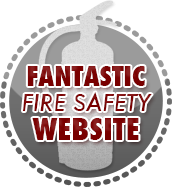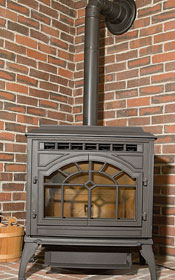Fire Extinguisher : 101
Wood Fire Safety 101
| Home |
| About Fire Extinguishers |
| Using a Fire Extinguisher |
| Fire Prevention |
| Fire Hazards |
| First Aid for Fire |
| Financial Protection |
| Biggest Fires in History |
| Firefighters |
This site was voted:

by onlinefiresciencedegree.org
(scroll to 74 on the list)
This article is intended to provide individuals with general tips about fire safety when installing alternative heating systems. |
As the cost of utilities and home-heating fuels continues to increase, many homeowners have switched to alternative forms of heating. As a way of saving money and helping the environment, alternative methods such as using wood stoves, fireplaces and kerosene heaters are very useful. Unfortunately, despite their many advantages, with their use, the risk of a home fire increases. An alternative form of heating is not necessarily dangerous, but does require the homeowner to exercise caution and take responsibility in the installation, use and maintenance of the home’s heating equipment by following proper fire safety guidelines.
 Wood stoves and fireplaces are effective and efficient ways of heating your home. Fire safety begins when you select the model. There are many wood stoves and fireplaces on the market, but make sure that the one you select is of good quality, well-designed and UL listed. At the time of purchase, read the information on the package and be aware of the manufacturer’s warranty as this may give you a good idea as to the model’s maintenance requirements and life expectancy. Before you even think about installing your new system, have your chimney inspected and cleaned by a professional. This is especially necessary if you have not used your chimney in some time. When installing your wood stove or fireplace, be sure that it is installed properly by setting it at least 36 inches from combustible surfaces and providing it with adequate floor support. Once your unit is installed, place a glass or metal screen in front to prevent sparks from flying. Do not use excessive amounts of paper when building a fire as it can cause creosote in the chimney to ignite. Finally, never allow a fire to burn while you sleep. And, when you close the damper before going to bed, check that the fire is well extinguished as there is the possibility that it may rekindle and emit carbon monoxide in the house.
Wood stoves and fireplaces are effective and efficient ways of heating your home. Fire safety begins when you select the model. There are many wood stoves and fireplaces on the market, but make sure that the one you select is of good quality, well-designed and UL listed. At the time of purchase, read the information on the package and be aware of the manufacturer’s warranty as this may give you a good idea as to the model’s maintenance requirements and life expectancy. Before you even think about installing your new system, have your chimney inspected and cleaned by a professional. This is especially necessary if you have not used your chimney in some time. When installing your wood stove or fireplace, be sure that it is installed properly by setting it at least 36 inches from combustible surfaces and providing it with adequate floor support. Once your unit is installed, place a glass or metal screen in front to prevent sparks from flying. Do not use excessive amounts of paper when building a fire as it can cause creosote in the chimney to ignite. Finally, never allow a fire to burn while you sleep. And, when you close the damper before going to bed, check that the fire is well extinguished as there is the possibility that it may rekindle and emit carbon monoxide in the house.
If you are using synthetic logs in your wood stove or fireplace, make sure that you closely follow the directions on the package. While the log is burning, do not attempt to break it apart and do not use more than one synthetic log at a time. Because synthetic logs often burn unevenly, increasing the amount of logs in your fireplace or stove can cause dangerous levels of carbon monoxide. Reading the instructions on the materials burned in stoves or fireplaces is something that too many homeowners forget to consider, but it is crucial!
A kerosene heater is another effective and efficient alternative home heating method. There are, however, several factors you should be aware of before lighting your kerosene heater. First, make sure that your heater is in good working condition. This means you should inspect its parts for carbon buildup as it is a common cause of home fires. Second, make sure that there is proper ventilation in the room as kerosene heaters can give off potentially deadly fumes. You should also know where the model’s emergency shut off is located, in the case of an unexpected ventilation problem. Third, only use the fuel suggested by the manufacturer on the package; using a different fuel can have disastrous results. Also, this fuel should be well-contained in store-approved metal containers and kept outside of the home. As a final fire safety precaution, do not ever attempt to fill the heater while it is in operation or when it is hot. This could cause overflow and severe burns.
Written by John Manley
Having experienced 2 house fires, John Manley now devotes some of his spare time educating people about the importance of having fire extinguishers, CO and fire alarms, and proper escape plans though the website: Fire Extinguisher: 101 - www.fire-extinguisher101.com.